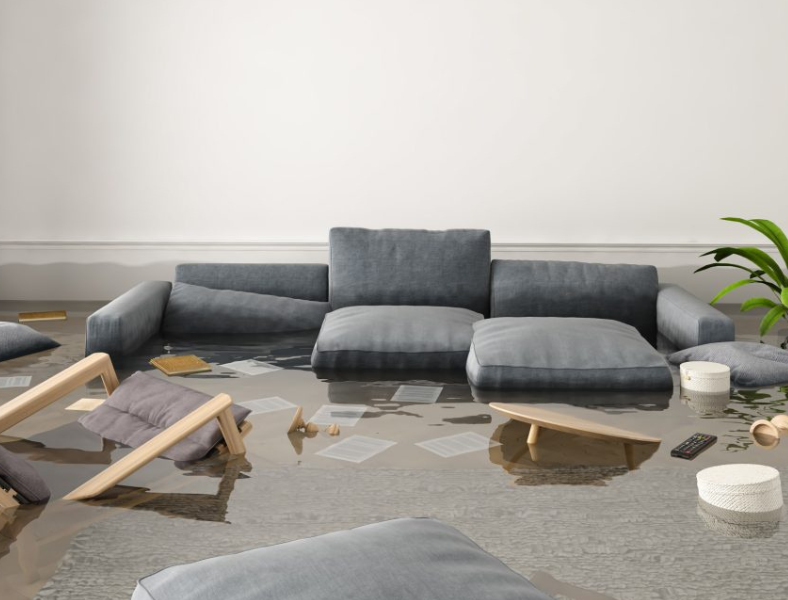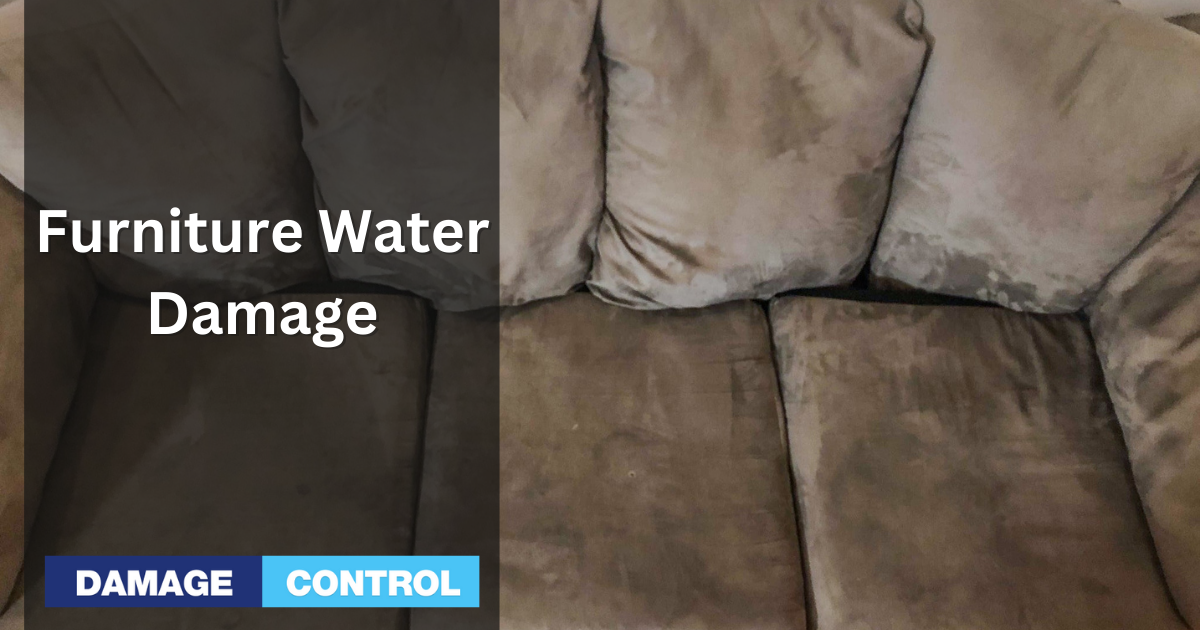Have you ever spilled a glass of water on your favorite couch or had a leaky pipe ruin your coffee table? If so, you've experienced furniture water damage – a pesky problem that affects countless homes and offices every year.
But don't worry – by taking some simple steps, you can prevent furniture water damage and deal with it effectively if it does occur.
We'll explore the causes of furniture water damage (think floods, leaks, spills, and humidity), and provide tips on protecting your furniture from harm.
By the time you're done reading, you'll be a furniture water damage prevention pro! So, grab a seat (one that's dry, of course) and let's get started.
Signs of Furniture Water Damage
When it comes to furniture water damage, identifying it early is key. Here are some signs to look out for:
Discoloration
Water stains on furniture are one of the most obvious signs of water damage. They may appear as a white or gray ring or mark, and can be difficult to remove.
Warping
When wood furniture gets wet, it can warp or bend out of shape. Look for visible warping or buckling in the affected areas.
Cracking
Water-damaged furniture may develop cracks in the finish or the wood itself. These cracks can weaken the structure of the furniture and may be a sign that the damage is severe.
Musty odors
One of the less obvious signs of water damage is a musty or moldy smell. This can signify that moisture has penetrated the furniture and mold is growing inside.
If you notice any of these signs, acting quickly is important to prevent further damage.
Types of Furniture that are Most Prone to Water Damage
Not all furniture is created equal when it comes to water damage. Some types are more vulnerable than others. Here are a few examples:
Upholstered furniture
Fabric and foam used in upholstered furniture can absorb and retain moisture for long periods, making it more prone to mold growth and structural damage.
Particleboard furniture
Particleboard furniture, made from compressed wood fibers, is particularly vulnerable to water damage. It can easily warp, swell, and disintegrate when exposed to moisture.
Antique furniture
Antique furniture may be more delicate and susceptible to damage than newer pieces, especially if they haven't been properly sealed or treated.
Health Risks Associated with Water-Damaged Furniture
In addition to causing damage to your furniture, water damage can pose health risks. Here are some potential hazards to be aware of:
Mold
Mold growth is one of the most significant health risks of water-damaged furniture. Mold can cause respiratory problems, allergies, and even infections.
Bacteria
Water-damaged furniture can also be a breeding ground for bacteria, which can cause infections and other health issues.
Chemicals
Water damage can cause furniture finishes to break down, releasing potentially harmful chemicals into the air.
To minimize the risk of exposure to these hazards, it's important to address water damage as soon as possible and take steps to prevent it from happening in the first place.
Preventing Furniture Water Damage
Prevention is the best medicine when it comes to furniture water damage. Here are some tips to keep your furniture dry and protected:
Use waterproof covers
If you have upholstered furniture or furniture near windows or doors, consider using waterproof covers to protect it from moisture.
Keep furniture away from windows and doors
Speaking of windows and doors, keeping furniture away from them is a good idea to avoid exposure to rain, snow, and other types of moisture.
Windows are a common place for condensation to build up, creating the moisture needed to damage and worse, promote mold growth.
Address leaks immediately
If you notice a leak in your home or office, don't wait to address it. The longer you wait, the more damage it can cause.
Use dehumidifiers
If you live in a humid environment, consider using dehumidifiers to help control the higher levels of moisture in your home or office.
Inspect and maintain furniture
Regularly inspect your furniture for signs of water damage, and maintain it by applying protective finishes or sealants as needed.
By taking these simple steps, you can help prevent furniture water damage and ensure the longevity of your furniture.
Steps to Take When Furniture is Water Damaged
 If your furniture has been water-damaged, it's important to act quickly to prevent further damage and restore it as much as possible.
If your furniture has been water-damaged, it's important to act quickly to prevent further damage and restore it as much as possible.
Here are the 6 steps to take when furniture is water-damaged:
Remove furniture from the wet area
If the furniture is still wet, move it to a dry area as quickly as possible. This will help prevent further damage and allow the furniture to dry out.
Dry the furniture off
Use towels or a wet/dry vacuum to remove excess moisture from the furniture. If the furniture is particularly wet, you may want to use fans and a dehumidifier to speed up the drying process.
The quicker you dry it, the better the odds of saving the furniture. Fans and a dehumidifier are imperative if you were flooded.
Assess the damage
Take a closer look at the furniture to see how extensive the damage is. If the damage is severe, you may need to take more thorough steps to restore the furniture.
Sand and paint
If the furniture has been stained or discolored by water, sanding and repainting can help restore its appearance. You may also need to replace any damaged parts, such as warped or cracked wood.
Watch out for mold
Keep an eye out for any signs of mold growth on the furniture. If you notice any, it's important to address it quickly to prevent further damage and potential health risks.
Assess the long-term effects
Even if you can restore your furniture, water damage can still have long-term effects. Be sure to watch for any ongoing damage or issues, such as warping or cracking.
By following these steps, you can minimize the damage caused by water and help restore your furniture to its former glory.
DIY vs Professional Furniture Water Damage Repair
When repairing furniture water damage, you have two options: attempt to do it yourself or hire a professional. Here are some pros and cons to consider for each:
The DIY Route
Before you jump out in the deep, let’s discuss the pros and cons of doing it yourself or bringing in professionals.
Pros
Cost-effective: Doing it yourself can be much cheaper than hiring a professional.
Personal satisfaction: Completing a project can be rewarding and give you a sense of accomplishment.
Cons
Risk of further damage: If you don't know what you're doing, attempting to repair furniture water damage can cause more harm than good.
Lack of Expertise
It's not easy to fully restore water-damaged furniture without the proper tools and knowledge.
Professional
Pros:
Expertise
Hiring a professional ensures that the job will be done correctly, with the right tools and techniques.
Time-saving
A professional can complete the job much faster than you can, leaving you with more time to focus on other things.
Cons:
Cost
Hiring a professional can be more expensive than attempting to repair yourself.
Trust issues
You must be careful when choosing a professional, as not all are reputable.
Suppose you hire a professional, research and choose someone with a good reputation and experience in furniture water damage repair. Look for online reviews, ask for references, and check for any certifications or training. And don't be afraid to ask questions or voice any concerns you may have.
By weighing the pros and cons of each option, you can choose the best approach for your situation and ensure that your water-damaged furniture is restored properly.
Insurance Coverage for Furniture Water Damage
Dealing with furniture water damage can be stressful, but if you have insurance, it can be much easier to handle.
Here's what you need to know about insurance coverage for furniture water damage:
Types of Insurance Policies
Homeowner's Insurance
This policy may cover furniture water damage caused by a covered peril, such as a burst pipe or a natural disaster like a flood.
Renter's Insurance
If you rent your home, renter's insurance may cover water damage to your personal belongings, including furniture.
What is Covered
Water damage caused by a covered peril: If the water damage was caused by a covered peril, such as a burst pipe or flood, it may be covered by your insurance policy.
Personal belongings
If your furniture is damaged due to the water damage, it may be covered by your policy as a personal belonging.
Steps to File a Claim
 Contact your insurance company: As soon as you notice the water damage, contact your insurance company to file a claim. Be sure to provide as much information as possible, including photos and a detailed description of the damage.
Contact your insurance company: As soon as you notice the water damage, contact your insurance company to file a claim. Be sure to provide as much information as possible, including photos and a detailed description of the damage.
Document the damage
Take photos and videos of the damage, and keep all receipts related to repairs or replacement.
Meet with an adjuster
Your insurance company may send an adjuster to assess the damage and determine how much coverage you're entitled to.
Get estimates
Get estimates from contractors or furniture repair professionals for repairing or replacing the damaged furniture.
By taking these steps and working with your insurance company, you can ensure you receive the coverage you're entitled to for furniture water damage.
Conclusion
Dealing with furniture water damage can be a hassle, but addressing it quickly and effectively is important to prevent further damage and potential health risks.
By being proactive and taking the necessary steps to prevent and address furniture water damage, you can ensure that your furniture remains in good condition for years to come. Don't hesitate to take action and restore your furniture to its former glory!

